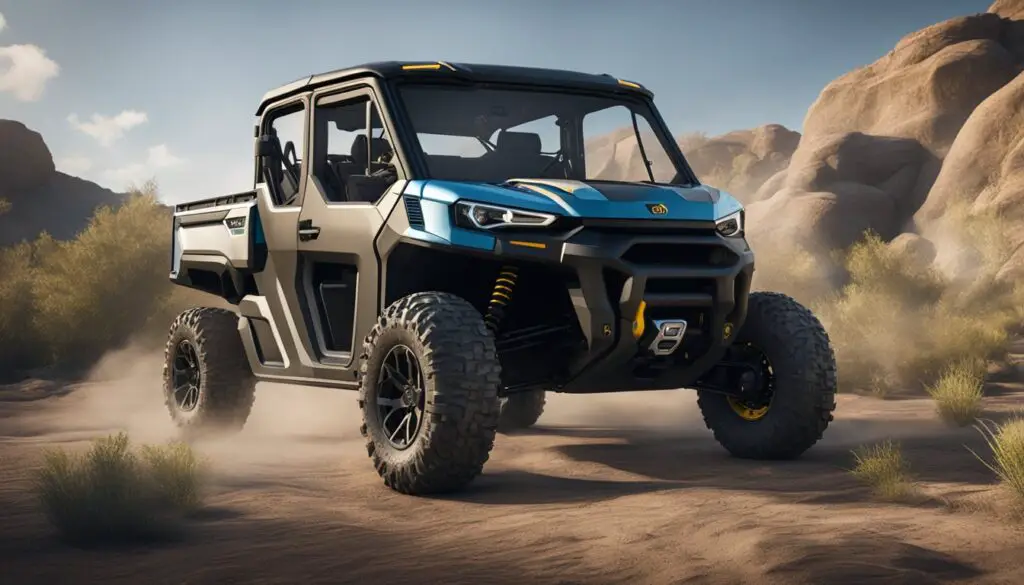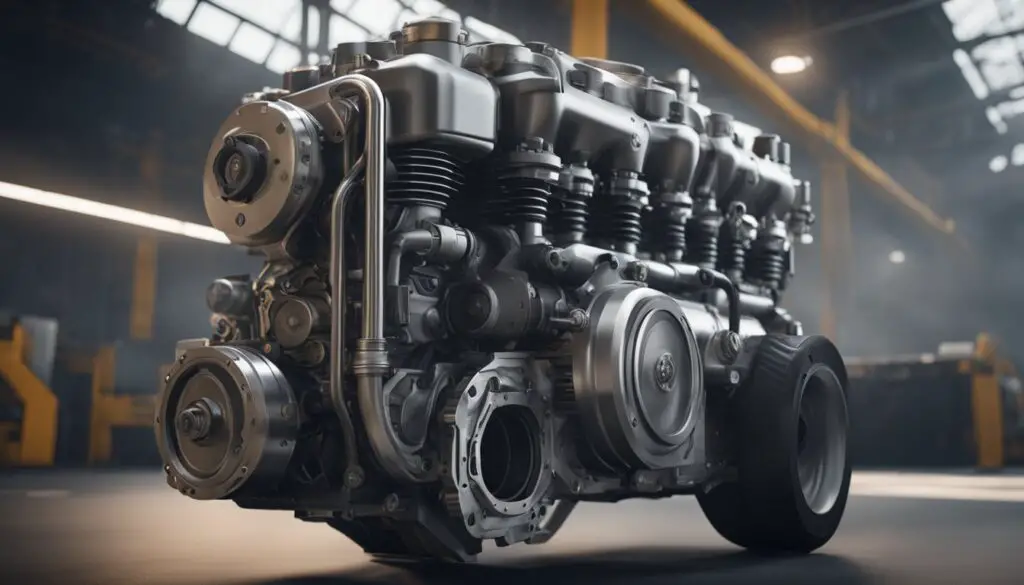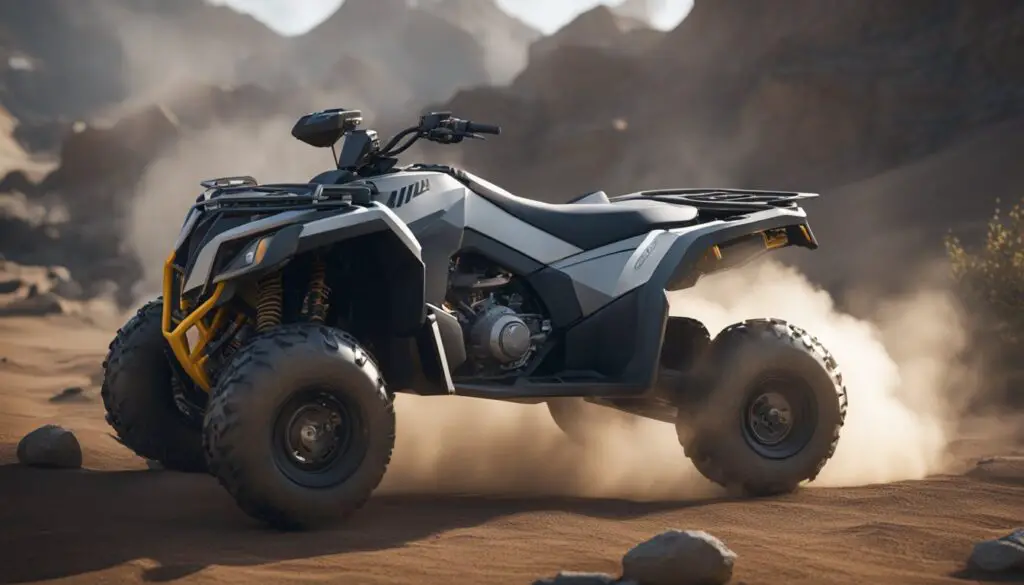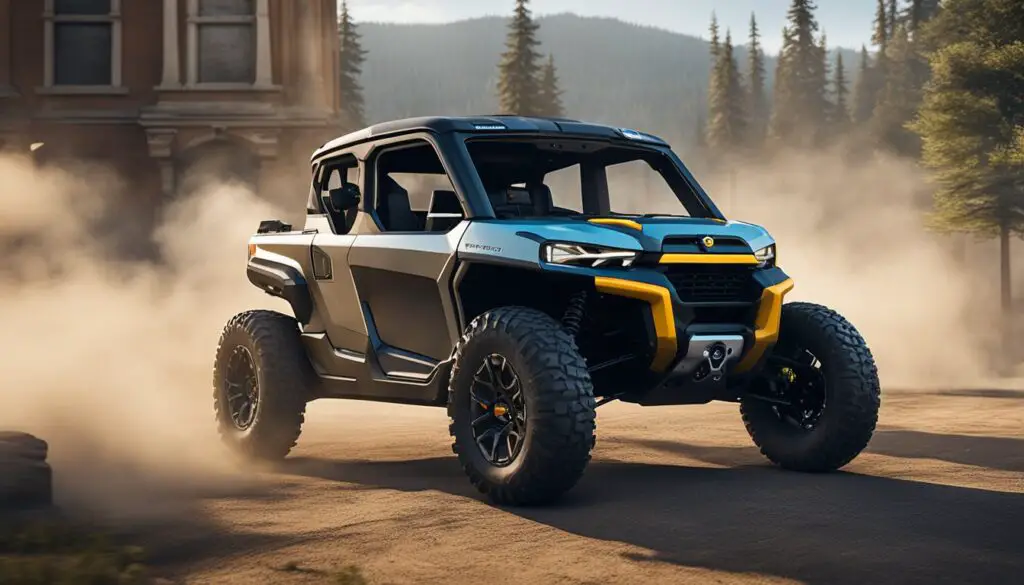Overheating in the Can-Am Defender can catch any off-road enthusiast by surprise and put a damper on your riding experience. Understanding the reasons behind this common issue is essential for maintaining your vehicle’s performance and longevity. From insufficient airflow to cooling system malfunctions like a faulty thermostat or a failing water pump, various factors can lead to your Defender feeling the heat.
Related read: Common Problems with Can Am Defender: Troubleshooting Guide

When you notice your Defender’s temperature gauge climbing higher than usual, it’s a clear sign that something isn’t right. Smoke, loss of power, or an engine that feels unusually hot to the touch can all indicate overheating. If you’re dealing with spewing coolant, like in the instance of the unfortunate owner who left their HD10 idling for too long, it’s definitely time to investigate.
Addressing an overheating issue promptly saves you from more significant engine damage. Regularly check your Defender’s cooling fan, radiator, and ensure there’s enough coolant before hitting the trails. If you run into an overheating problem, it’s critical to halt your ride and attend to the fix immediately to prevent further damage and secure your UTV’s reliability for your next adventure.
Understanding Can-Am Defender Overheating
When your Can-Am Defender starts to overheat, it can be both inconvenient and harmful to the vehicle’s longevity. It’s crucial to recognize the symptoms, pinpoint common issues, and understand potential causes to address overheating effectively.
Symptoms of Overheating
- Steam or Smoke: If you notice steam or smoke emanating from the engine area, take immediate action.
- Temperature Gauge: Keep an eye on the dashboard. A high reading on your temperature gauge is a clear indicator.
- Unusual Smells: A sweet, burning smell could signal leaking and burning coolant.
- Performance Issues: Your Defender may show a reduction in power or responsiveness.
Identifying Common Problems
- Coolant Leaks: Check for puddles under the vehicle or inspect the radiator and hoses for signs of leakage.
- Faulty Thermostat: This component must function correctly to regulate engine temperature.
- Ineffective Water Pump: It’s responsible for circulating coolant. Any malfunction can lead to overheating.
Exploring Potential Causes
- Insufficient Airflow: Ensure nothing blocks the airflow to your radiator.
- Cooling Fan Malfunctions: Your cooling fan needs to be in good working order.
- Clogged Radiator: Debris can obstruct airflow and coolant circulation within the radiator.
- Extended Idle Time: Avoid letting your vehicle idle for too long without moving, as this can reduce cooling efficiency.
Preventative Maintenance
Preventative maintenance is crucial if you own a Can-Am Defender to avoid overheating. By adhering to a routine maintenance schedule, you can help ensure your vehicle runs smoothly and minimize the risk of overheating issues.
Regular Checkups and Cleaning
Air Filter Maintenance:
- Check your air filter regularly for any build-up of dirt or debris; this can restrict airflow, causing your engine to run hotter.
- Clean or replace the air filter as needed to maintain proper engine ventilation.
Cooling System Maintenance
Coolant Levels:
- Inspect your coolant levels often; low levels can indicate leaks or evaporation.
- Top up or change the coolant according to your user manual’s recommendations to maintain optimum engine temperature.
Radiator Care:
- Clean the radiator fins to prevent clogging from mud or leaves, which can hinder heat dispersion.
- Inspect the radiator for damage or corrosion that could affect its function.
Key Component Inspections
Thermostat and Water Pump:
- Check the thermostat for proper operation, as a faulty one can lead to overheating.
- Verify that the water pump is functioning correctly to circulate coolant effectively.
Following this maintenance guide can help reduce the likelihood of your Can-Am Defender overheating and keep it in top condition.
Diagnosing Overheating Issues

When your Can-Am Defender starts to overheat, it’s crucial to systematically diagnose the issue to prevent engine damage. By checking the cooling system, engine and fuel system, and electrical components, you can often pinpoint and fix the problem.
Cooling System Diagnosis
Check the Radiator: Ensure your radiator isn’t clogged with mud or debris, as airflow is essential for cooling. Look closely at the fins; if they’re bent or obstructed, they can’t dissipate heat effectively.
- Coolant Levels: Verify that the coolant levels are adequate. Low levels might suggest a leak, which needs immediate attention.
- Cooling Fan Operation: Confirm that the cooling fan kicks in when required. If the fan is faulty or the wiring is damaged, it won’t help to reduce the heat.
Engine and Fuel System Checks
Inspect Spark Plugs: Worn or fouled spark plugs can cause the engine to run inefficiently, leading to overheating. Remove and examine them for signs of wear or damage.
- Fuel Pump Function: A failing fuel pump can lead to an engine running too hot. Listen for unusual noises and check for proper fuel flow.
- Air Filter Inspection: Make sure your air filter is not clogged. Restricted air intake can cause the engine to overheat due to the engine straining to perform.
Electrical System Assessment
Wiring Harness: Look over the wiring harness for any signs of damage, wear, or corrosion. Faulty wiring can cause components like the cooling fan to malfunction.
- Check Fuses: Ensure all fuses related to the cooling system are intact. A blown fuse could be the simple reason why something isn’t working.
- ECU Scan: If accessible, use a scanner to check for any fault codes that might indicate issues with the sensors or other electrical components controlling the engine’s temperature.
Cooling Efficiency and Airflow

Maintaining your Can-Am Defender’s cooling system is vital for preventing overheating and ensuring optimal performance. Proper airflow through the radiator and around the engine is key to dissipating heat efficiently.
Maximizing Radiator Performance
To maximize radiator performance:
- Keep it clean: Your radiator’s ability to cool the engine is greatly reduced when mud, dirt, and debris clog its fins. Periodically check the radiator and gently clean out any build-up to maintain proper heat exchange.
- Inspect the cooling fan: Ensure your fan is in good working condition. A faulty fan can’t circulate air properly, leading to increased engine temperatures.
Enhancing Cabin Ventilation
For enhancing cabin ventilation:
- Look for ventilation options: Some models may allow you to add more cabin vents, which can help improve airflow and reduce heat buildup inside your vehicle.
- Heat shields: Install heat shields where available. They can protect the cabin from engine heat, improving both comfort and airflow.
Improving External Airflow
Tips on improving external airflow:
- Avoid tight covers: When your Defender is idle, avoid tight covers that can trap heat. Ensure there’s enough space for air to circulate and cool the engine.
- Regular checks: Examine for any barriers to external airflow. Sometimes, stuck leaves or other natural debris can block air intake or exhaust pathways. Clear these regularly.
Mechanical Integrity and Wear

When tackling the issue of overheating in your Can-Am Defender, it’s crucial to consider mechanical integrity and the effects of wear over time. These factors can lead to a decline in performance and can be the root cause of your overheating problems.
Engine Wear Factors
Engine wear is a reality that potentially affects your Can-Am Defender’s performance and could lead to overheating. Specific factors contributing to engine wear include:
- Age: Over time, engine components can deteriorate, reducing efficiency.
- Maintenance: A lack of regular maintenance can accelerate wear.
- Operating Conditions: Harsh driving conditions can lead to faster wear.
Your engine’s endurance is linked to internal factors, such as:
- Worn Piston Rings or Valve Guide Seals: These can lead to excessive oil consumption and cause a drop in engine pressure.
- Fouled Spark Plugs: If these are worn or dirty, they can misfire and reduce efficiency, making your engine work harder and possibly overheat.
Drive System and Belt Evaluation
The drive system and specifically the belt are critical to your Can-Am Defender’s operations, influencing not just your ride’s performance but also its tendency to overheat. Keep an eye out for:
- Belt Problems: Cracks and wear in the belt weaken its integrity.
- Clutch System: Issues with the clutch can increase friction and heat.
- Steering Components: If these are worn, they can put additional stress on the engine and drive system, contributing to overheating.
Check the belt for:
- Tension: The correct tension ensures that the belt operates smoothly.
- Wear Patterns: These can indicate misalignment within the drive system.
Routine inspections and proactive maintenance of your Can-Am Defender’s engine and drive system can help keep your vehicle running efficiently and avoid the unwelcome issue of overheating.
Fuel and Ignition Systems

Your Can-Am Defender’s efficient operation hinges on the optimal functioning of both fuel and ignition systems. When issues arise, they can significantly impact engine performance, leading to stalling or poor acceleration.
Fuel System Management
Fuel Pump: Ensure that your fuel pump is delivering the proper pressure. A malfunctioning fuel pump can lead to inadequate fuel supply, which might cause your engine to overheat.
Fuel System Maintenance: Regular checks on your fuel lines and connections are vital. Clogged or leaky fuel lines can disrupt fuel flow, influencing engine temperature and performance.
Ignition System Troubles
Ignition Switch: A faulty ignition switch can result in an engine that’s hard to start or stalls unexpectedly, so inspection and timely replacement are key.
Spark Plugs: Your engine’s spark plugs should always be in good condition. If your Defender is experiencing stalling or problems with acceleration, check for:
- Correct spark plug gap
- Signs of wear or corrosion
- Proper firing from the ignition coils
Starter Motor: If starting your Defender is difficult, the starter motor may be at fault. Listen for unusual sounds when starting the engine, as these can indicate starter motor issues.
Power Steering and Handling

When you’re tackling tough terrain in your Can-Am Defender, the performance of your power steering is crucial for smooth handling. Maintaining your steering system and addressing handling difficulties promptly can ensure a pleasurable ride.
Steering System Maintenance
Your Can-Am Defender relies on a well-maintained steering system for optimal performance. Regular checks on your power steering fluid levels and steering components can save you from unexpected issues. Here are quick maintenance tips:
- Check Power Steering Fluid: Ensure that the fluid is at the proper level and isn’t contaminated. Low power steering fluid can result in tougher handling and potentially damage the steering rack.
- Inspect Steering Components: Look for visible signs of wear or damage to the steering rack and related components. Catching any problems early can prevent steering issues while driving.
Handling Difficulties and Solutions
If your Defender starts to show handling problems, it’s important to act fast. Steering issues often present themselves as stiffness in the steering wheel or the vehicle pulling to one side. Here’s how you can address these challenges:
- Power Steering Performance: If your steering isn’t as responsive as it should be, check if the power steering system is working properly. This includes ensuring that the power steering fluid hasn’t boiled due to overheating.
- Upgrade Tires and Lifts: Non-standard tires and lift kits can affect handling. Always ensure that any modifications are compatible with your vehicle’s power steering capabilities.
Remember, the key to great handling is making sure your power steering system is in top shape and any alterations to your Defender are steering-friendly.
Durability for Off-Roading
The Can-Am Defender thrives when it’s navigating the rugged landscapes you love. Built to withstand the bumps and grinds of off-road adventures, this UTV ensures durability is at the forefront.
Tackling Tough Terrain
When you challenge tough terrain, the Can-Am Defender’s suspension system shines. It is engineered to absorb the jolts and jars of rocky, uneven ground, allowing a smoother ride for you and improved stability for the vehicle. Here’s what to expect:
- Robust shock absorbers and suspension arms designed for off-road durability.
- High ground clearance to avoid obstacles that might harm the undercarriage.
Suspension and Towing Capacity
Your off-road experience can involve towing gear or transporting supplies. The Can-Am Defender is equipped for such tasks with a substantial towing capacity. To put things into perspective:
- Towing capacity: Up to 2,500 lbs, depending on the model.
- Integrated hitch receiver for straightforward hookup.
The suspension plays a key role in how the Defender handles loads:
- Heavy-duty** rear suspension** aids in maintaining stability even when towing near-maximum capacity.
- Balanced load distribution, crucial for when you’re navigating uneven off-road environments while hauling.
Remember, while the Defender is a champion at off-roading, always monitor coolant levels and watch for signs of overheating to prevent any interruptions in your adventure.
Electrical Components and Sensors
Your Can-Am Defender’s performance relies heavily on its electrical system, particularly its components and sensors, which can impact how your vehicle handles overheating. Ensuring that these elements function correctly is crucial for preventing and diagnosing overheating issues.
Sensor Checks and Replacements
Sensors play a pivotal role in monitoring the engine’s health, and when it comes to overheating, they are your first line of defense. It’s essential to regularly check the following:
- Coolant Temperature Sensor: Ensures it’s providing accurate readings. If you notice erratic temperature gauge readings or your Defender goes into limp mode, consider replacing the sensor.
- Thermostat Sensor: A faulty one can cause incorrect engine temperature regulation. Check for error codes that might indicate a malfunction.
- How to Check:
- Use a multimeter to confirm the correct voltage and resistance levels.
- Inspect for any damaged wiring or connections, as these can cause incorrect sensor readings.
- How to Replace:
- Locate the sensor—refer to your owner’s manual.
- Disconnect the battery before removing the sensor to avoid shorts.
- Replace with a compatible new sensor and reconnect the electrical leads.
Dealing with Electrical Failures
Your Defender’s robust performance can be hampered by electrical failures, which often occur due to faulty wiring or fuses. Here’s how you can address such issues:
- Check the fuses regularly; replace any that appear blown or damaged.
- Inspect wiring for signs of wear, corrosion, or damage. Pay attention to the relay and switch connections, as these can be failure points.
- ECU (Electronic Control Unit) malfunctions can also lead to overheating. It manages various engine functions, and any issues might trigger limp mode or other malfunctions.
- How to Address:
- Relay: Test with a multimeter to ensure it is engaging properly. If not, replace it.
- Wiring: Look for any exposed or frayed wires and repair or replace as necessary.
- ECU: If ECU-related problems are diagnosed, they typically require professional attention.
By staying diligent with these checks and acting promptly when issues arise, you can enhance reliability and reduce the risk of overheating.
Troubleshooting Advanced Issues
When you’re dealing with an overheating engine, it’s important to approach the problem methodically. Early detection and correct diagnosis are key to resolving issues without incurring high costs or causing further damage to your Can-Am Defender.
Investigating Overheating Engine
Causes:
- Insufficient airflow: Check if anything is blocking the airflow to the radiator.
- Cooling fan issues: Confirm the fan kicks in; if not, inspect for electrical malfunctions or a seized motor.
- Thermostat malfunction: Test the thermostat in hot water to see if it opens; replace if faulty.
- Water pump failure: Listen for unusual noises from the water pump, which could indicate a malfunction.
Action Steps:
- Inspect the radiator for any debris or blockages and clean it thoroughly.
- Check coolant levels; top up or replace fluid if necessary, ensuring there are no leaks.
- Monitor temperature gauges closely for abnormal readings which may indicate a problem.
Resolving Complex Mechanical Faults
Starting Problems:
- Battery: Ensure it’s fully charged and terminals are clean.
- Fuel System: Check for blockages or leakages that could affect engine performance.
Professional Mechanic:
- If these steps do not resolve the overheating, consult a professional mechanic who can conduct a detailed engine analysis and offer effective solutions based on advanced diagnostics.
Effective Solutions:
- Replace damaged parts only with OEM components to maintain engine integrity.
- Regular maintenance: Every solution should be complemented by a strict maintenance schedule to prevent future occurrences of similar issues.
Aftermath of Overheating
When your Can-Am Defender overheats, it’s crucial to assess the damage carefully and strategize for repairs or replacement of damaged parts to ensure your vehicle runs smoothly again.
Damage Assessment
After your Can-Am Defender has overheated, you need to conduct a thorough damage assessment to understand the impact. Key components to check include:
- Cooling System: Look for signs of coolant leakage and check if the radiator hoses are intact.
- Engine Components: Examine for any visible damage and look for a blown head gasket, which is a common consequence of overheating.
- Corrosion: Inspect for corrosion that may have been accelerated by excessive heat.
Identifying the extent of damage early on can prevent further issues and pave the way for an effective repair plan.
Repair and Replacement Strategies
Developing repair and replacement strategies is vital for getting back on track:
- Consult a Professional Mechanic: A skilled mechanic can provide an accurate diagnosis and recommend the best course of action for repairs.
- Replacement Parts: Based on the assessment, some parts may need to be replaced. Common replacements include:
- Thermostat
- Water pump
- Cooling fan
- Address Corrosion: If corrosion is found, affected parts should be repaired or replaced promptly to stop further decay.
By following these steps, you can tackle overheating consequences methodically and minimize the chance of future overheating incidents.
Optimizing Can-Am Defender Use
To enhance the Can-Am Defender’s performance and ensure its longevity, you’ll want to focus on performance, comfort, and utility. These modifications can make your Defender more suited for farm work, hauling, or recreational use, while keeping you comfortable during operation.
Enhancing Performance
Regular Cooling System Maintenance: Keep your Defender’s cooling system in check to prevent overheating, especially when used in heavy-duty conditions.
- Check for adequate airflow; clean any debris from the radiator.
- Inspect the cooling fan and thermostat for proper operation.
Power Train Upkeep: For optimal performance, ensure that your engine and clutch system are regularly serviced. This helps in maintaining proper functioning under stress.
Increasing Comfort and Longevity
Ergonomic Adjustments:
- Install comfortable seating with ample support to reduce fatigue during long rides.
- Upgrade with weather protection accessories such as a cabin enclosure to improve comfort in various climates.
Vehicle Protection:
- Apply protective coatings and regularly wash your Defender to prevent rust and wear.
- Make use of preventative maintenance schedules to extend the life of your vehicle.
Utility and Versatility
Customizable Attachments:
- Utilize attachments suitable for hauling, plowing, or other farm utility tasks, enhancing the Defender’s versatility.
- Choose attachments that are easy to install and remove to adapt to different uses quickly.
Enhancing Airflow for Heavy-Duty Use:
- Make sure there’s sufficient airflow to the engine and clutches when hauling heavy loads.
- Consider adding performance air filters or a larger radiator for better heat dissipation.
Technical Specifications and Upgrades
In addressing overheating issues with Can-Am Defender models, it’s essential to know your vehicle’s specifications and consider specific upgrades that can enhance cooling efficiency.
Understanding Specific Models
When it comes to the Can-Am Defender, each model comes with unique technical specs that can influence the propensity for overheating. For instance:
- Can-Am Defender HD8: This model is powered by a 799.9 cc V-twin which provides robust performance but may require additional cooling strategies during extreme climates or heavy use.
- Can-Am Outlander 450 & 570: Known issues with these models include overheating, which may stem from heavy workloads or blocked air flow to the engine.
- Can-Am Defender HD5: A smaller displacement engine at 427 cc, the HD5 may run cooler than its larger counterparts but is still susceptible to overheating under certain conditions.
For each of these models, maintaining clean radiators and ensuring adequate airflow is crucial. Regular maintenance is key to preventing overheating issues.
Upgrade Options and Efficacy
Several upgrades can help increase the cooling efficiency of your Can-Am UTV. Here’s a quick look at the options:
- High-flow Radiators: Upgrading to a larger radiator can help disperse heat more effectively.
- Performance Fans: Installing a high-performance fan such as a Spal fan can improve air movement through the radiator.
- Coolant Additives: Certain additives can enhance the thermal transfer properties of your coolant, helping to reduce engine temperatures.
| Upgrade Type | Expected Benefit | Model Compatibility |
|---|---|---|
| High-flow Radiators | Increased heat dispersion | HD8, Outlander 450/570, HD5 |
| Performance Fans | Enhanced airflow | HD8, Outlander 450/570, HD5 |
| Coolant Additives | Improved thermal transfer | HD8, Outlander 450/570, HD5 |
Remember, the efficacy of each upgrade will vary depending on how you use your Can-Am Defender and the climates you typically drive in. Always consider both the short-term and long-term effects of the upgrades on your vehicle’s performance and reliability.
Frequently Asked Questions
When tackling the issue of overheating in your Can-Am Defender, knowing what signs to look for and the steps to remedy them can save you from expensive repairs. The information below will guide you through common queries you may encounter with overheating problems.
What are common symptoms indicating my Defender might be overheating?
If your Defender is overheating, you may notice the temperature gauge reading high, steam from the engine compartment, a decrease in engine performance, or strange smells like burning or hot coolant.
How can I fix an overheating issue in my Can-Am Defender?
To fix an overheating issue in your Can-Am Defender, first ensure that the coolant level is adequate. Check the radiator for any clogs and ensure the water pump is functioning correctly. If these parts are operational, consider inspecting the thermostat, which might need a replacement.
Where is the thermostat located in a Can-Am Defender?
The thermostat in a Can-Am Defender is usually located near the engine, often housed within a thermostat housing which can be found by tracing the upper radiator hose back to where it connects to the engine.
What should I do if my Can-Am Defender’s fan stops working?
If your Defender’s fan stops working, check the fuse and relay to ensure they’re functioning. If the fan is receiving power but not operating, it may need to be replaced. Checking the wiring for any signs of damage is also recommended.
What could be causing my side-by-side to overheat repeatedly?
Repeated overheating could be caused by a persistent low coolant level, a malfunctioning thermostat, a clogged radiator, an issue with the water pump, or a fan not operating as it should be. It could also be a sign of a more serious mechanical problem, like a head gasket failure.
What are the potential consequences if my ATV overheats?
Overheating can lead to severe engine damage, such as warped components, cracked cylinder heads, or a seized motor. It is crucial to address overheating issues promptly to avoid these costly repairs.

Leave a Reply